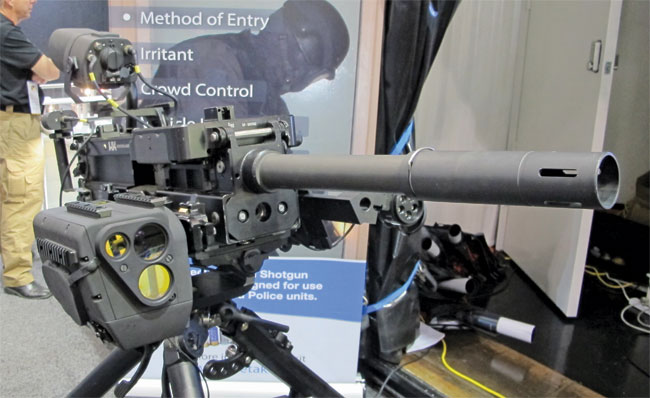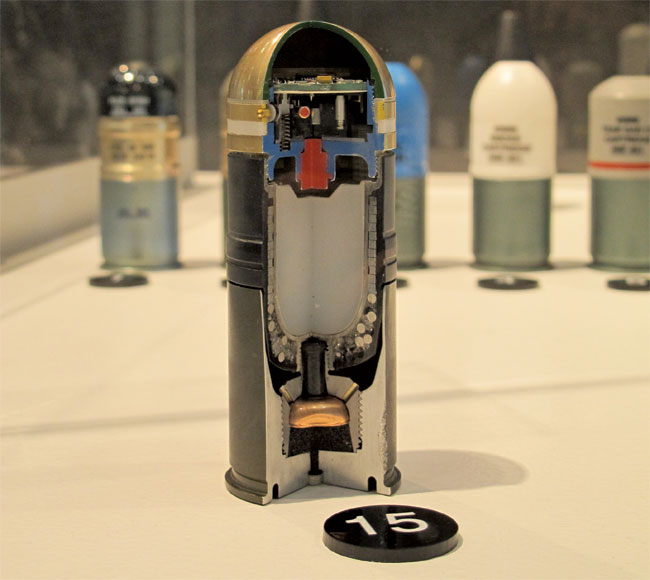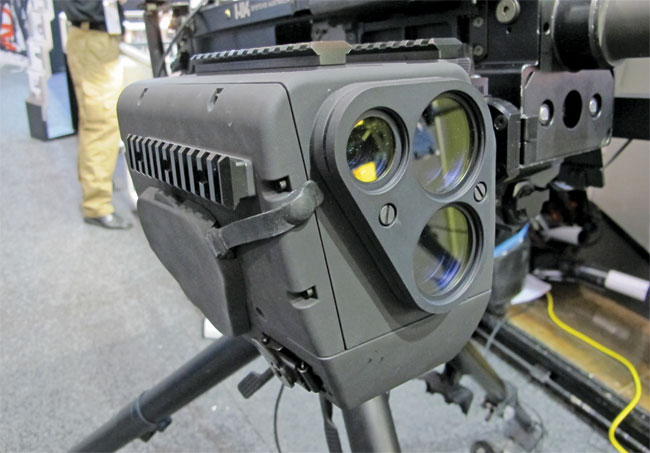ABOVE: General Dynamics Armament and Technical Products (GDATP) MK47 Mod 0 Advanced Lightweight Grenade Launcher with Raytheon AN/PVG-1 Lightweight Video Sight (LVS) as seen at the NIOA shoot at Land Warfare Conference 2012. (NIOA Australia)
Under Land 40 Phase 2 (L40/2), the Australian Defence Materiel Organisation (DMO) are intending to deliver two new direct fire support weapons to the Army’s infantry battalions and special operations forces, and to the Royal Australian Air Force’s Airfield Defence Guards. The first, the Medium Direct Fire Support Weapon (MDFSW), has already been selected and fielded, with the M3 Carl Gustav 84mm recoilless rifle replacing the M2 variant previously in service. The second system, slated to be a “Light Weight Automatic Grenade Launcher (LWAGL) fitted with a night sight and a fire control system,” has yet to be selected.
The L40/2 program has been the subject of some controversy, with the original tender having closed in October 2007 and no systems having been introduced to date. Two contending systems were shortlisted for trials in 2008. The first pairs the Heckler & Koch Grenade Machine Gun (GMG E) with the Vingmate Fire Control System (FCS) and Softmount Combi from Vinghøg AS of Norway (now part of Rheinmetall Defence), and two different 40x53mm Air Burst Munitions (ABM) from Rheinmetall Defence. The second contender is the General Dynamics Armament and Technical Products (GDATP) MK47 Mod 0 system (also known as the Striker 40), outfitted with the AN/PVG-1 Lightweight Video Sight (LVS) developed by Raytheon and optimised for the MK285 Programmable Pre-fragmented High Explosive (PPHE) 40x53mm round, developed by Nammo AS of Norway.
As Australian Defence Magazine reported in July 2010, it is an open secret that the winning bidder was Melbourne-based Point Trading, who originally offered the HK GMG E with Vingmate FCS pairing. In April 2011, a Department of Defence spokesperson told the Sydney Morning Herald that Defence had “cancelled contract negotiations with the preferred tenderer because it became clear that the company was not going to deliver what Defence had assessed it had promised.” The spokesperson went on to say that Defence might turn to “off-the-shelf” weapons used by allies in Afghanistan, thought to be a nod to the MK47 in use with USSOCOM forces there. The contract was put back out to tender, and the program appears to have stalled.
The introduction of a LWAGL with an advanced FCS will be advantageous for Australian forces for a number of reasons, with many of these benefits stemming from the increased first round hit probability. This eliminates the need to ‘walk’ fire on to a target when engaging, allowing an operator to maintain the element of surprise, engage multiple targets rapidly, and reduce ammunition consumption (which, in turn, results in longer mission endurance). The accuracy of these systems also lends itself to reducing collateral damage, and the airburst capability allows operators to engage targets in defilade. Accurate first round hit capability is also important when firing shaped charge munitions (such as HEDP) against armoured vehicles or hardened targets such as bunkers.
Both contenders’ systems offer significant advantages over the MK19 Mod 3 currently in service with Australian forces. The MK19 weighs in at 35.0 kg, first entered service in 1968, and features no fire control system in its present package. The MK19 is in service with elements from the Australian Army, Royal Australian Air Force, and the Australian Special Operations Command (SOCOMD), and the LWAGL selected is expected to be evaluated for use by each of these elements as well.
Whilst the blowback operated HK GMG E fires from an open bolt, like most automatic grenade launchers, the MK47 is a short recoil operated, locked breech weapon that fires from the closed bolt position. From a design point of view, this can allow for a more accurate first round fired. Firing from the open bolt position, however, gives a weapon better cooling characteristics, and can allow for a higher rate of fire. In fact, GDATP give the MK47’s cyclic rate of fire as “225 – 300 rounds per minute,” with sources indicating the system is not ideal for extended automatic fire. The HK GMG E, meanwhile, has a cyclic rate of 340 rounds per minute; the MK19 Mod 3 sits at 300 – 400. Of course, with an increased first round hit probability for the new systems, the rate of fire becomes less important.
The MK47 is a mere 18 kg, with the LVS weighing an additional undisclosed amount (known to be heavier than the Vingmate), whilst the GMG E weighs in at 29 kg plus an additional 5.8kg for the Vingmate FCS. Both systems are notably lighter than the 35 kg of the current MK19 Mod 3. Whilst the MK47 is certainly the lighter of the two contenders, both are expected to be frequently deployed as vehicle-mounted weapons, which may limit the MK47’s weight advantage. The MK47 mounts on the MK108 Mod 0 tripod, whilst the HK GMG E mounts on the Vinghøg Softmount Combi, which is also capable of accepting the M2 heavy machine gun, MK19 grenade launcher, and – in the future – possibly the M240 GPMG. The GMG/M2 and MK19/M2 mounts are qualified and in service. Rheinmetall also hope their Softmount Combi will be considered as an upgrade for the existing MK19 fleet. These mounts would allow the weapon to use the Vingmate FCS and thermal weapons sights, and become airburst munition capable.
Both weapons operate on a “laze, aim, fire” principle, allowing the video sights to determine the range to target and adjust for the specific ballistic profile of the round chambered. Both sights feature a selectable range of munitions that affect the ranging and aiming procedure. The Raytheon LVS marks the target location once it has been lazed, allowing the operator to quickly move the ‘donut’ reticule back to the target and fire. This feature, which could be particularly useful in scenarios such as targeting a particular window in an apartment building, is strangely absent from the Vingmate FCS. The MK47 features a nylon-sheathed Kevlar pull cord for charging, which is supposedly close to indestructible. Despite this, the weapon requires a long pull from the lower rear of the housing to charge the weapon, which may be an issue in some vehicle-mounted applications, such as firing from a partially-enclosed turret.
The current MK47 sight, the Raytheon Lightweight Video Sight (LVS), features a black & white display with image intensification (I2) capability, Picatinny (Mil-Std 1913) rails along the top for thermal weapons sights (such as AN/PAS-13 HTWS ), and unique connectors for each component, making them impossible to assemble incorrectly. It was originally designed in Canada. A second-generation sight for the MK47, the so-called “Low Cost FCS,” has recently been announced and will feature colour imaging, networking capability, image capture/share options, and thermal integration. There has also been discussion regarding the possible ability to charge from vehicle power sources. NIOA, the distributor for the MK47 and FCS in Australia, have billed it as “the most sophisticated FCS available for crew served weapons,” and have stressed its suitability for use with The MK19 and M2 systems as well.

The Vingmate FCS is built around a colour day camera with multiple FOV options, a laser rangefinder, ballistics computer, GPS, and DMC. It also features a modular design to provide an ability to meet future requirements; it is able to mount other optics/sensors and give them the same ballistic compensation as the integral capabilities. These may include thermal weapons sights, IR/visible laser markers, and so on. Ongoing improvements to the Vingmate FCS are expected.
Both sights take into account target range, difference in elevation between weapon and target, corrective data input by the user, and ballistic tables, including spin drift compensation. The net result of this is a dramatic increase in first round hit probability, particularly at extended ranges. This, in turn, reduces the need to expend additional ammunition and time to defeat the target. Firing fewer rounds can also decrease the potential for collateral damage, and increase mission endurance. These FCSs also allow for more controlled and precise grouping and dispersion of multiple rounds.
The incorporated zoom functions, night cameras, and laser rangefinders also increase units’ situational awareness and allow for accurate Intelligence, Surveillance, and Reconnaissance (ISR) data to be gathered by the operating force. These help contribute to positive target identification out to the maximum range of the weapon systems, and allow operators to make use of these various functions without having to change to different devices such as laser rangefinders, thermal sights, binoculars, and so on.
The Vingmate FCS is particularly relevant to the modern battlefield, allowing system operators to share collected imagery and data with other units and within the command structure. Once connected to a Battlefield Management System (BMS), the Vingmate can transfer target data or collected ISR as necessary, contributing to the situational awareness and operational picture of fellow units and the force at large. The Vingmate system is designed with the quick and simple upgrade of software and ballistic tables in mind, allowing for the easy addition of data for new ammunition types, for example. This can be conducted on the user’s end, without having to be returned to Vinghøg. The Vingmate FCS was developed alongside a dedicated video simulator, the VingSim Trainer. This allows operators to perform simulated training, gaining proficiency with the system’s software menus, selection of various ammunition types, and programming of the various fire modes. This sort of training saves on the notable cost of firing live airburst ammunition, which would otherwise be necessary (as training ammunition cannot simulate AB functionality), and can allow gunners more time on the system.
Both of the competing system integrators have partnered with munitions manufacturing firms to provide a programmable airburst munition for their respective weapons. GDATP have partnered with Nammo AS of Norway to offer the MK285 Mod 0 Programmable Pre-fragmented High Explosive (PPHE) 40×53 cartridge. This has been in use with United States Special Operations Command (USSOCOM) forces since 2004, with over 100,000 rounds of MK285 having been fired in combat zones to date, mostly in Afghanistan and Iraq. The MK285 features a projectile designed by Diehl Munitions in Germany, the MK438 Mod 0 fuze manufactured by Bofors Defence in Sweden, and a cartridge case designed by NICO in Germany, integrated by Nammo.
Rheinmetall is offering their Airburst Munitions (ABM) in two varieties, High Explosive (HE) and High Explosive Dual Purpose (HEDP). The former is similar to the MK285, intended for use against infantry and infantry in cover, whilst the latter is intended to defeat light and medium vehicles, whilst retaining some effectiveness against infantry in defilade. The HEDP round will penetrate approximately 80mm of Rolled Homogenous Armour (RHA). Rheinmetall can offer these rounds in mixed belts, if required by the customer.
Both the Rheinmetall and Nammo offerings are powered by kinetic energy, requiring no on-board battery in the projectile, and both feature point detonating, airburst, and self-destruct function modes. In the case of the MK285, the self-destruct initiates approximately 18 seconds after launch. The Rheinmetall ABM cartridges have a self-destruct function that initiates 20 seconds after launch. Both the Rheinmetall and Nammo cartridges are Insensitive Munitions (IM) compliant, meaning they are less likely to detonate if hit by fragmentation, stray projectiles, or blast effects. This is becoming an increasingly attractive property for munitions, particularly those likely to be carried in vehicles, with the current threat climate being saturated with improvised explosive devices (IEDs).
Both systems are compatible with non-airburst ammunition, and fire a range of U.S. and NATO-approved 40×53 rounds. The MK47 was tested with all 40×53 ammunition in the U.S. inventory, at a cost of over $1 million USD. It is interoperable with all cartridges in U.S. use. A source familiar with the HK GMG E described the weapon as able to “feed literally anything,” and told us the weapon was tested with a range of both NATO and U.S. standard ammunition. Both weapons use standard M16A2 disintegrating links, and are supplied with ammunition packaged in boxes of 32 or 48 rounds.
Projectiles are programmed differently in the two competing systems. The older MK47 Mod 0 programs the projectiles in the barrel of the weapon, using three contacts to impart fuze mode, timing, and other details to the round. This system cannot be jammed, is not affected by changing battlefield conditions, and guarantees the projectile is programmed before leaving the barrel of the weapon. The Rheinmetall ABM rounds for the HK weapon, meanwhile, are programmed through the use of light in the infrared spectrum – the Velan IR-PU (Infrared Programming Unit), developed by Vinghøg, sends out twenty ‘telegram signals’ that are detected by eight receivers built into the ABM projectile. Once the projectile receives four identical telegram signals, the fuze is programmed and the round enters ‘lock down’ mode, making it impossible to reprogram. Each projectile is programmed individually. Because rounds are programmed after they have left the barrel, this system can be fitted to any existing AGL. This method of programming also results in much lower power consumption.
This author was provided the opportunity to fire the MK47 at Land Warfare Conference 2012, in Victoria, Australia. The system functions were quick to pick up, and with minimal instruction it was possible to punch out two passenger windows on the side of a minivan at just under 250m with one round for each. Unfortunately, the GMG/Vingmate combination was not available for live fire testing, however simulator-based instruction proved the system’s controls to be very intuitive and straightforward. In Australia, the total system price for the MK47 with LVS is thought to be around the $100,000 AUD mark as of late 2012. The price of the HK-based system is unknown at this time.
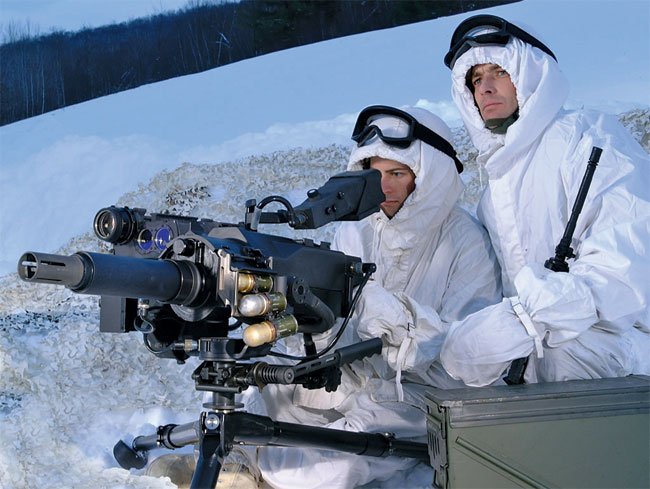
Whilst the MK47 has been fielded since May 2004, only 1,500 systems are in use. These are overwhelmingly with United States Special Operations Command (USSOCOM) units, with the weapon seeing use with both Army and Navy components. One former U.S. Navy Special Warfare operator described the system as “formidable” in training scenarios, but expressed concerns about using it under field stress conditions. For this reason, he noted that he had never personally used the weapon on operations, and had used the MK19 instead. The MK47 is also in limited use in the Israeli Defence Forces, and a 2010 foreign military sale is recorded for 130 units to be supplied to an undisclosed country. The HK/Vingmate system has been fielded since 2009, with approximately 500 systems thought to be currently fielded. The weapon has seen use with the Norwegian, New Zealand, and Canadian contingents in Afghanistan. An important note is that some Vingmate FCS systems have been delivered to USSOCOM for use on the MK47 gun itself, as a replacement for the ageing LVS. The Vingmate systems delivered to USSOCOM for the MK47 also program the MK285 round in the barrel of the MK47, in the same way as the LVS.
Vinghøg partnered with BAE Systems, HK, and Nammo for the Close Area Suppression Weapon (CASW) program in Canada, which delivered 300+ units designated the C16. The C16 features the same HK GMG E and Vingmate FC combination as is being offered to the ADF, with the substitution of Nammo ammunition. Canada was, in fact, the first customer for the 40x53mm RF-ABM airburst munition from Nammo. Since then Vinghøg, as part of Rheinmetall, have been heavily involved in the development of the Velan IR-PU. Nammo, Vinghog, and H&K have also teamed up for the ongoing 40mm program in Norway.
Whilst both systems offer distinct advantages over Australia’s current service weapon, the differences between the systems are also notable. The MK47 Mod 0 is certainly a very lightweight automatic grenade launcher, weighing in at approximately 11 kg less than the HK GMG E. It also possesses a number of attractive design features, most notably its operating system allowing it to fire from the closed bolt position. The Raytheon LVS, however, simply cannot compare with the significant advantages offered by the Vingmate FCS paired with the HK system. A colour camera, modular future-proofed design, ability to export important target/ISR data and imagery to a BMS, GPS incorporation, and the lightweight nature of the sight itself make this FCS the obvious choice of the two. However, with the second generation sight for the MK47 – the “Low Cost FCS” – now being marketed and due for release ‘in the near future,’ this advantage may soon be whittled away. The Rheinmetall ABM rounds have some advantages over the Nammo MK285, in both lethality and the existence of an HEDP projectile, however they are largely comparable. Finally, the Vinghøg Softmount Combi appears to be an excellent mounting solution, capable of multi-role use with a range of common fire support weapons.
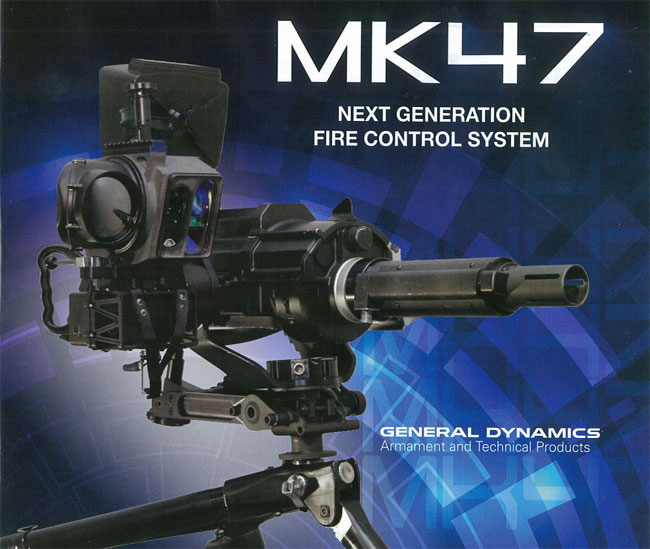
Defence, and DMO in particular, are playing their cards close to their chest. Brigadier Mike Phelps, Director General of the DMO’s Integrated Soldier Systems Branch gave a presentation in May 2012 which noted that the acquisition strategy for the LWAGL was “under review” – if anything has changed in the past 15 months or more, Defence have not disclosed details. Despite multiple requests for information and the submission of detailed questions addressing all parts of the process, Defence would only say: “The LAND 40-2 project schedule was delayed as a result of the termination of contract negotiations of the Lightweight Automatic Grenade Launcher capability, on February 28 2011. On December 12, 2012, LAND 40-2 was listed as a project of concern. Defence is reviewing the outstanding Light Weight Automatic Grenade Launcher requirement, and has provided advice for government consideration on the way forward for the project.”
Employees from both contending companies expressed frustration with the handling of the program. It is no surprise that Land 40/2 has been listed as a “project of concern,” we can only hope that our soldiers in the field get the enhanced capability promised by a LWAGL system sooner rather than later.





